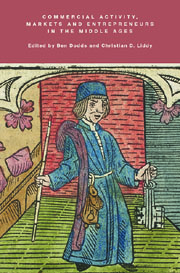 Commercial Activity, Markets and Entrepreneurs in the Middle Ages
Commercial Activity, Markets and Entrepreneurs in the Middle Ages Book contents
- Frontmatter
- Contents
- List of Figures
- List of Tables
- List of Contributors
- List of Abbreviations
- Richard Britnell: An Appreciation
- 1 Unreal Wages: Long-Run Living Standards and the ‘Golden Age’ of the Fifteenth Century
- 2 Minimum Wages and Unemployment Rates in Medieval England: The Case of Old Woodstock, Oxfordshire, 1256–1357
- 3 Crisis Management in London's Food Supply, 1250–1500
- 4 Grain Shortages in Late Medieval Towns
- 5 Market Regulation in Fifteenth-Century England
- 6 Self-Government in the Small Towns of Late Medieval England
- 7 Marketing and Trading Networks in Medieval Durham
- 8 Peasant Opportunities in Rural Durham: Land, Vills and Mills, 1400–1500
- 9 The Shipmaster as Entrepreneur in Medieval England
- 10 Cheating the Boss: Robert Carpenter's Embezzlement Instructions (1261×1268) and Employee Fraud in Medieval England
- 11 The Public Life of the Private Charter in Thirteenth-Century England
- 12 Luxury Goods in Medieval England
- Index of People and Places
- Bibliography of the Writings of Richard Britnell
- Tabula Gratulatoria
12 - Luxury Goods in Medieval England
Published online by Cambridge University Press: 05 February 2013
- Frontmatter
- Contents
- List of Figures
- List of Tables
- List of Contributors
- List of Abbreviations
- Richard Britnell: An Appreciation
- 1 Unreal Wages: Long-Run Living Standards and the ‘Golden Age’ of the Fifteenth Century
- 2 Minimum Wages and Unemployment Rates in Medieval England: The Case of Old Woodstock, Oxfordshire, 1256–1357
- 3 Crisis Management in London's Food Supply, 1250–1500
- 4 Grain Shortages in Late Medieval Towns
- 5 Market Regulation in Fifteenth-Century England
- 6 Self-Government in the Small Towns of Late Medieval England
- 7 Marketing and Trading Networks in Medieval Durham
- 8 Peasant Opportunities in Rural Durham: Land, Vills and Mills, 1400–1500
- 9 The Shipmaster as Entrepreneur in Medieval England
- 10 Cheating the Boss: Robert Carpenter's Embezzlement Instructions (1261×1268) and Employee Fraud in Medieval England
- 11 The Public Life of the Private Charter in Thirteenth-Century England
- 12 Luxury Goods in Medieval England
- Index of People and Places
- Bibliography of the Writings of Richard Britnell
- Tabula Gratulatoria
Summary
What was the importance of luxury goods in the medieval economy? It has often been assumed or implied that trade in high-value commodities and the manufacture of luxuries lay at the heart of medieval towns and their commercial life. Richard Britnell has done more than anyone to advance an alternative view, but no one has faced the subject head on, as this essay attempts to do.
Luxury is one of those difficult terms which cannot be strictly and easily defined. The word is constantly used by historians, who refer to ‘luxury goods’ and people involved in the ‘luxury trades’. We think that we know a luxury when we see one, or read about it in a document: a piece of jewellery skilfully made from precious metals, like the fifteenth-century swan livery badge of enamelled gold found at Dunstable, or the ‘silver pitcher for wine’ weighing more than three pounds listed in the wardrobe inventory of Walter de Merton (along with many other items of silver plate) in 1277. Dishes for a meal prepared elaborately by professional cooks and incorporating expensive ingredients such as spices would be easily categorised as luxurious, as would clothing tailored from imported textiles such as silks or fine woollens, and lined with furs from the Baltic. Leisure activities or pastimes which involved a lavish use of resources, such as court entertainments or hunting, could be included among luxuries.
- Type
- Chapter
- Information
- Commercial Activity, Markets and Entrepreneurs in the Middle AgesEssays in Honour of Richard Britnell, pp. 217 - 238Publisher: Boydell & BrewerPrint publication year: 2011


